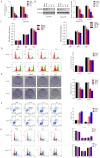SNRPB2: a prognostic biomarker and oncogenic driver in esophageal cancer via β-catenin/c-Myc signaling
- PMID: 40303992
- PMCID: PMC12037380
- DOI: 10.3389/fonc.2025.1536473
SNRPB2: a prognostic biomarker and oncogenic driver in esophageal cancer via β-catenin/c-Myc signaling
Abstract
Background: The SNRPB2 gene encodes Small Nuclear Ribonucleoprotein Polypeptide B2, a crucial component involved in RNA splicing processes. While SNRPB2 dysregulation has been observed in various cancers, its role in esophageal cancer (ESCA) remains unclear.
Methods: The mRNA level of SNRPB2 in ESCA was evaluated in combination with TCGA, GTEX, and GEO databases. The prognostic value of SNRPB2 was assessed using Kaplan-Meier analysis. Immunohistochemistry (IHC) was employed to confirm the expression of the SNRPB2 protein in tumor tissues from clinical samples. The biological functions of SNRPB2 were assessed in vitro cell assay and in vivo tumor models. The molecular mechanisms were determined by correlation and gene set enrichment analysis. Western blot experiments validated involvement in signaling pathways.
Results: Our findings unveiled that SNRPB2 was upregulated at both mRNA and protein levels in ESCA, which was associated with the pathological progression of the disease. Additionally, SNRPB2 served as a robust prognostic biomarker, implicated in driving oncogenic functions in ESCA. It facilitated cell proliferation, migration, and invasion, transitioned the cell cycle, and inhibited apoptosis. Mechanistically, SNRPB2 activated genes associated with the β-catenin/c-Myc signaling pathway, such as β-catenin, c-Myc, CCNA2, CCNB1, CDK1, and CDK2. This activation also regulated the epithelial-to-mesenchymal transition (EMT), thereby facilitating the progression of ESCA.
Conclusion: Our findings demonstrate that SNRPB2 contributes to ESCA progression by regulating the β-catenin/c-Myc axis, suggesting its potential as a prognostic biomarker and therapeutic target for ESCA patients.
Keywords: EMT; SNRPB2; esophageal cancer; prognostic marker; β-catenin/c-Myc signaling pathway.
Copyright © 2025 Bao, Tian, Pan, Guo, Yang, Gan and Zheng.
Conflict of interest statement
The authors assert that they do not have any known competing financial interests or personal relationships that could have been perceived to influence the work reported in this paper.
Figures









Similar articles
-
SNRPB2 facilitates esophageal squamous cell carcinoma oncogenesis and progression via E2F4 stabilization.Front Immunol. 2025 Jun 19;16:1610721. doi: 10.3389/fimmu.2025.1610721. eCollection 2025. Front Immunol. 2025. PMID: 40612943 Free PMC article.
-
Kinesin family member 23 knockdown inhibits cell proliferation and epithelial-mesenchymal transition in esophageal carcinoma by inactivating the Wnt/β-catenin pathway.Funct Integr Genomics. 2023 May 10;23(2):154. doi: 10.1007/s10142-023-01088-y. Funct Integr Genomics. 2023. PMID: 37162618
-
Bridging Integrator 3 (BIN3) Downregulation Predicts a Poor Prognosis in Patients with Esophagus Carcinoma: A Study based on TCGA Data.Comb Chem High Throughput Screen. 2023;26(11):1974-1989. doi: 10.2174/1386207326666221205101815. Comb Chem High Throughput Screen. 2023. PMID: 36475339 Free PMC article.
-
Ubiquitin-specific protease 15 contributes to gastric cancer progression by regulating the Wnt/β-catenin signaling pathway.World J Gastroenterol. 2021 Jul 14;27(26):4221-4235. doi: 10.3748/wjg.v27.i26.4221. World J Gastroenterol. 2021. PMID: 34326621 Free PMC article.
-
Good or not good: Role of miR-18a in cancer biology.Rep Pract Oncol Radiother. 2020 Sep-Oct;25(5):808-819. doi: 10.1016/j.rpor.2020.07.006. Epub 2020 Aug 12. Rep Pract Oncol Radiother. 2020. PMID: 32884453 Free PMC article. Review.
Cited by
-
Small nuclear ribonucleoprotein polypeptide B2 regulated by SNHG4/miR-204-5p axis inhibits ferroptosis to aggravate the progression of hepatocellular carcinoma.Discov Oncol. 2025 Jul 16;16(1):1349. doi: 10.1007/s12672-025-03192-w. Discov Oncol. 2025. PMID: 40670855 Free PMC article.
References
LinkOut - more resources
Full Text Sources
Miscellaneous

